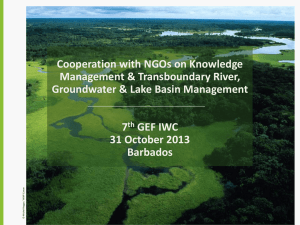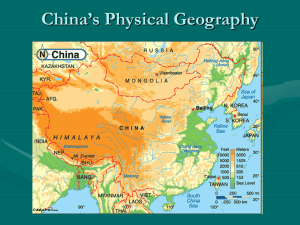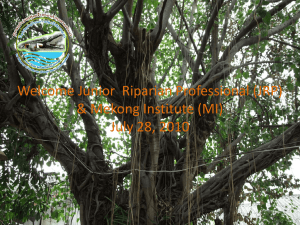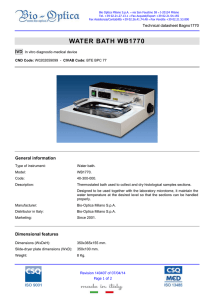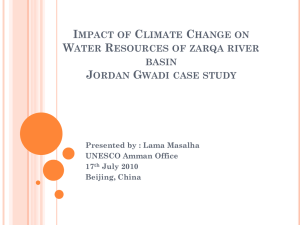What is an Outfall Reconnaissance Inventory?
advertisement
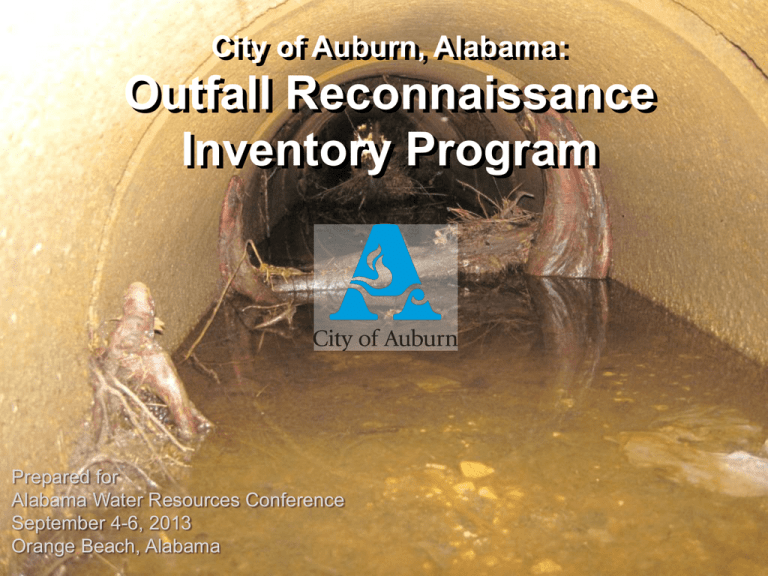
City City of of Auburn, Auburn, Alabama: Alabama: Outfall Reconnaissance Inventory Program Prepared for Alabama Water Resources Conference September 4-6, 2013 Orange Beach, Alabama Presentation Outline I. Introduction & Background II. What is an Outfall Reconnaissance Inventory? III. Planning, Prioritizing, and Managing Field Investigations IV.Tracking and Documentation V. Data Review and Analysis VI.Summary and Conclusions Introduction and Background Location Tallapoosa Chattahoochee Lee County Legend Lee County Auburn University Phase II Population Served – Around 60,000 Phase II Coverage – 60+/- Sq. Miles Tallapoosa River Basin City of Auburn Phase II Annexed ACT99_577 Annexed Storm Sewer – 100+ Miles of Pipe Receiving Waters – 450 Miles of Stream What is an Outfall Reconnaissance Inventory? Outfall Reconnaissance Inventory • Involves – – – – – Field Location Documentation Evaluation Mapping Characterization Iron Floc Anyone? of all permitted and unpermitted discharges to either the MS4 or its receiving waters. • City of Auburn * This includes identification and inventory of other WQ related concerns An Outfall Reconnaissance Inventory Should be Done to: • Meet/Exceed IDDE component of MS4 permit **Can be Low Cost • Familiarization of jurisdiction • ID other concerns (erosion etc.) • ID maintenance concerns • Assess All SS aerial crossings • ID BMP opportunities (restoration) • Most importantly - to gain intimate knowledge of your system An Outfall Reconnaissance Inventory Should be Completed: • ASAP • Reevaluate every 5 years or sooner • Should arguably be done prior to implementation of ANY on the ground BMP other than education and outreach • Should be performed in dry conditions, preferably at least 72-hours after any significant storm event Planning, Prioritizing, and Managing Field Investigations How to Plan for Outfall Reconnaissance • Gather all existing information on stormsewer system • Gather all cartographic data (GIS if available) • Identify all TMDL or 303(d) listed waters • Delineate receiving basins into manageable units • Prioritize your schedule according to variables of impairment and/or local knowledge Know Your Limits. Jurisdictional Limits That Is! Gather Available Data SIMPLE ADVANCED Prioritization and Scheduling • Watersheds with Approved TMDL’s • Watersheds with 303(d) Listed Waters • Source Water Protection Area (Drinking Water Source) • Watersheds Designated as Critical Habitat • Outstanding Water Resources A Method of Prioritization 9 7 4 8 6 1 0 2 3 5 1 Schedule by Density Acreage Percent Area Ag/Pasture 228.51 8.95% Ag/Tilled 28.56 1.12% Coniferous 744.20 29.15% Acreage Percent Area Ag/Pasture 12.35 1.38% Ag/Tilled 14.41 1.62% Coniferous 449.79 50.45% Acreage Percent Area Ag/Pasture 93.81 7.86% Ag/Tilled 14.52 1.22% Coniferous 403.45 33.80% Acreage Percent Area Ag/Pasture 276.39 7.28% Ag/Tilled 46.02 1.21% Coniferous 1712.07 45.08% Acreage Percent Area Ag/Pasture 158.63 6.36% Ag/Tilled 39.76 1.59% Coniferous 945.64 37.90% Acreage Percent Area Ag/Pasture 104.20 3.31% Ag/Tilled 30.16 0.96% Coniferous 830.15 26.34% Acreage Percent Area Ag/Pasture 680.11 12.91% Ag/Tilled 83.22 1.58% Coniferous 2170.83 41.21% Acreage Percent Area Ag/Pasture 48.54 10.64% Ag/Tilled 3.73 0.82% Coniferous 198.65 43.52% Acreage Percent Area Ag/Pasture 2448.06 10.48% Ag/Tilled 299.80 1.28% Coniferous 9406.59 40.27% Acreage Percent Area Ag/Pasture 290.46 5.95% Ag/Tilled 29.90 0.61% Coniferous 2345.14 48.04% BASIN 1 LANDCOVER Deciduous Open 324.07 138.06 12.70% 5.41% BASIN 2 LANDCOVER Deciduous Open 180.34 35.34 20.23% 3.96% BASIN 3 LANDCOVER Deciduous Open 168.79 87.33 14.14% 7.32% BASIN 4 LANDCOVER Deciduous Open 839.67 202.62 22.11% 5.33% BASIN 5 LANDCOVER Deciduous Open 688.91 247.75 27.61% 9.93% BASIN 6 LANDCOVER Deciduous Open 1304.47 505.67 41.39% 16.04% BASIN 7 LANDCOVER Deciduous Open 1175.72 495.01 22.32% 9.40% BASIN 8 LANDCOVER Deciduous Open 169.43 12.91 37.12% 2.83% BASIN 9 LANDCOVER Deciduous Open 8070.19 2059.94 34.55% 8.82% BASIN 10 LANDCOVER Deciduous Open 1221.96 682.39 25.03% 13.98% Urban 1050.51 41.15% Water Urban 198.45 22.26% Water Urban 406.79 34.08% Water Urban 625.25 16.46% Water Urban 347.26 13.92% Water Urban 364.72 11.57% Water 12.26 0.39% Total 3151.63 100.00% Urban 500.26 9.50% Water 162.50 3.08% Total 5267.64 100.00% Urban Water 38.66 1.51% 0.96 0.11% 18.81 1.58% 96.01 2.53% 67.46 2.70% Total 2552.57 100.00% Total 891.64 100.00% Total 1193.50 100.00% Total 3798.03 100.00% Total 2495.41 100.00% 21.98 4.81% 1.19 0.26% Total 456.43 100.00% Urban 927.00 3.97% Water 148.23 0.63% Total 23359.80 100.00% Urban 279.51 5.73% Water Total 4881.83 100.00% % URBAN LC 32.47 0.67% Basin 1 Outfalls Headwalls Headwalls/Acre 440.00 0.17 Basin 2 Outfalls Headwalls Headwalls/Acre 96.00 0.11 Basin 3 Outfalls Headwalls Headwalls/Acre 173.00 0.14 Basin 4 Outfalls Headwalls Headwalls/Acre 58.00 0.02 Basin 5 Outfalls Headwalls Headwalls/Acre 63.00 0.03 Basin 6 Outfalls Headwalls Headwalls/Acre 52.00 0.02 Basin 7 Outfalls Headwalls Headwalls/Acre 0.00 0.00 Basin 8 Outfalls Headwalls Headwalls/Acre 4.00 0.01 Basin 9 Outfalls Headwalls Headwalls/Acre 0.00 0.00 Basin 10 Outfalls Headwalls Headwalls/Acre 21.00 0.00 HEADWALLS per ACRE Schedule Overlay Start Here! Getting Started – It Takes Two SAFETY IN NUMBERS Necessary Equipment Field Vest Spray Paint Field Book Tape Measurer Camera Machete Map ORI Field Sheets Boots Sunscreen Optional GPS Pocket Colorimeter Snake Chaps PVC Caps Use the IDDE Guidance Manual How to Manage Your Data Information Tracking Click Here **A Product of an Interdepartmental Collaboration Between City of Auburn Information Technology and Water Resource Management Departments Integrative Database Interdepartmental Benefits Create Custom PDF Reports/Work Orders Data Review and Analysis Progress – Year 4 • 3 Watersheds Completed • 225 Miles of Stream Surveyed • 1,161+ Outfalls Mapped and Assessed • 734 Water Quality Concerns Identified • 150+ Sanitary Sewer Aerial Crossings Inspected • Vast Increase in Local Knowledge Base! By The Numbers Unlikely 79% Potential 19% Suspect 1% Obvious 1% By The Numbers No 83% Yes 17% By The Numbers No 92% Yes 8% Highlights Importance of Preventative Maintenance!! Internal QA/QC Summary and Conclusions • INTIMATE PHYSICAL KNOWLEDGE OF YOUR WATERSHEDS IS INVALUABLE • ORI Can be Effective and Inexpensive Tool • Planning and Prioritization are Critical • Quality of Data Management will Determine How Much Benefit You Receive From Your Inventory • Share Information with other Departments and Regulatory Agencies!! Questions??? Daniel Ballard City of Auburn, Alabama Water Resource Management Department dballard@auburnalabama.org (334) 501-7367
